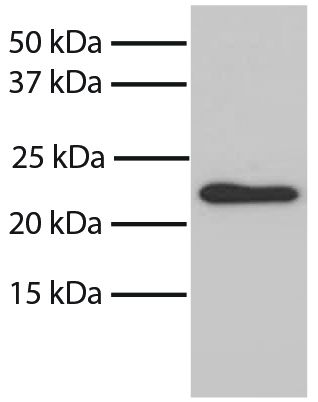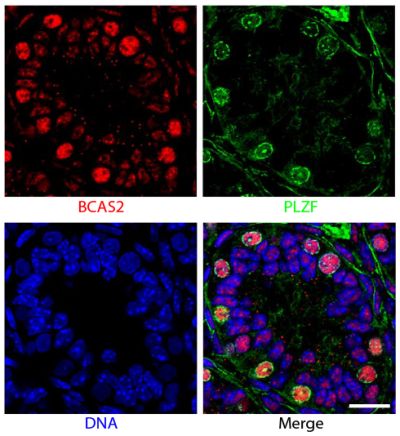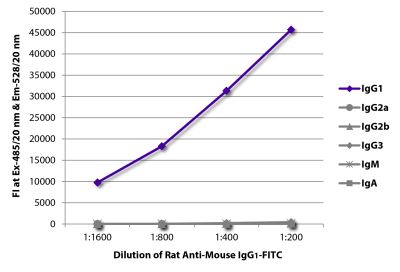Mouse Anti-Bax-UNLB (6A7)
Cat. No.:
10060-01
Purified Anti-Bax antibody for use in flow cytometry, immunohistochemistry / immunocytochemistry, electron microscopy, western blot, immunoprecipitation, and neutralization assays.
$208.00


| Clone | 6A7 |
|---|---|
| Isotype | Mouse IgG1κ |
| Isotype Control | Mouse IgG1-UNLB (15H6) |
| Specificity | Mouse/Rat/Human/Monkey/Bovine Bax |
| Alternative Names | Apoptosis regulator BAX, BCL2 associated X protein |
| Description | Bax is a 20-22 kDa member of the Bcl-2 family of proteins involved in regulation of programmed cell death, or apoptosis. In murine thymocytes, it is expressed primarily as a cytoplasmic protein. Over-expression of Bax promotes apoptosis by formation of homodimers and through heterodimerization with Bcl-2, an inhibitor of apoptosis. The monoclonal antibody 6A7 reacts with human, mouse and rat Bax but does not bind the soluble cytosolic form of Bax; however, treatment of cells with non-ionic detergents exposes the epitope and allows binding of 6A7 to monomeric forms of Bax but not Bax complexed with either Bcl-2 or Bcl-xL. |
| Immunogen | Bax peptide (a.a. 12-24) common to mouse, rat, and human |
| Conjugate | UNLB (Unconjugated) |
| Buffer Formulation | Borate buffered saline, pH 8.2 |
| Clonality | Monoclonal |
| Concentration | 0.1 mg/mL |
| Volume | 1.0 mL |
| Recommended Storage | 2-8°C |
| Applications |
Western Blot – Quality tested 2-5 Immunoprecipitation – Reported in literature 1,2,6,7 Flow Cytometry – Reported in literature 7-9 Immunohistochemistry-Frozen Sections – Reported in literature 4 Immunohistochemistry-Paraffin Sections – Reported in literature 5,10-12 Immunocytochemistry – Reported in literature 3,7-9,12-15 Electron Microscopy – Reported in literature 14,16 Neutralization – Reported in literature 17 |
| RRID Number | AB_2794108 |
| Gene ID |
12028 (Mouse) 24887 (Rat) 581 (Human) 718948 (Monkey) 280730 (Bovine) |
| Gene ID Symbol |
Bax (Mouse) Bax (Rat) BAX (Human) BAX (Monkey) BAX (Bovine) |
| Gene ID Aliases | BCL2L4 |
| UniProt ID |
Q07813 (Mouse Q63690 (Rat Q07812 (Human O02703 (Bovine |
| UniProt Name |
BAX_MOUSE (Mouse) BAX_RAT (Rat) BAX_HUMAN (Human) BAX_BOVIN (Bovine) |
Documentation
Certificate of Analysis Lookup
Enter the Catalog Number and Lot Number for the Certificate of Analysis you wish to view
- 1. Hsu Y, Youle RJ. Nonionic detergents induce dimerization among members of the Bcl-2 family. J Biol Chem. 1997;272:13829-34. (Immunogen, IP)
- 2. Li B, Dou QP. Bax degradation by the ubiquitin-proteasome-dependent pathway- Involvement in tumor survival and progression. Proc Natl Acad Sci USA. 2000;97:3850-5. (WB, IP)
- 3. Melino G, Bernassola F, Ranalli M, Yee K, Zong WX, Corazzari M, et al. p73 Induces apoptosis via PUMA transactivation and Bax mitochondrial translocation. J Biol Chem. 2004;279:8076-83. (WB, ICC)
- 4. Utsunomiya K, Watanabe J, Takamori Y, Kataoka Y, Kurokawa K, Yamada H. Crossreaction with an anti-Bax antibody reveals novel multi-endocrine cellular antigen. J Histochem Cytochem. 2004;52:805-12. (WB, IHC-FS)
- 5. Kudo W, Lee H, Smith MA, Zhu X, Matsuyama S, Lee H. Inhibition of Bax protects neuronal cells from oligomeric Aβ neurotoxicity. Cell Death Dis. 2012;3:e309. (WB, IHC-PS)
- 6. Hsu Y, Youle RJ. Bax in murine thymus is a soluble monomeric protein that displays differential detergent-induced conformations. J Biol Chem. 1998;273:10777-83. (IP)
- 7. Cheng S, Gao N, Zhang Z, Chen G, Budhraja A, Ke Z, et al. Quercetin induces tumor-selective apoptosis through downregulation of Mcl-1 and activation of Bax. Clin Cancer Res. 2010;16:5679-91. (IP, FC, ICC)
- 8. Bellosillo B, Villamor N, López-Guillermo A, Marcé S, Bosch F, Campo E, et al. Spontaneous and drug-induced apoptosis is mediated by conformational changes of Bax and Bak in B-cell chronic lymphocytic leukemia. Blood. 2002;100:1810-6. (FC, ICC)
- 9. Cabon L, Galán-Malo P, Bouharrour A, Delavallée L, Brunelle-Navas M, Lorenzo HK, et al. BID regulates AIF-mediated caspase-independent necroptosis by promoting BAX activation. Cell Death Differ. 2012;19:245-56. (FC, ICC)
- 10. Saatli B, Kizildag S, Posaci C, Dogan E, Koyuncuoglu M, Ulukus EC, et al. Long-term effects of GnRH agonist, GnRH antagonist, and estrogen plus progesterone treatment on apoptosis related genes in rat ovary. Fertil Steril. 2009;91:2006-11. (IHC-PS)
- 11. Wang X, Han W, Du X, Zhu C, Carlsson Y, Mallard C, et al. Neuroprotective effect of Bax-inhibiting peptide on neonatal brain injury. Stroke. 2010;41:2050-5. (IHC-PS)
- 12. Zaman F, Chrysis D, Huntjens K, Fadeel B, Sävendahl L. Ablation of the pro-apoptotic protein Bax protects mice from glucocorticoid-induced bone growth impairment. PLoS One. 2012;7(3):e33168. (IHC-PS, ICC)
- 13. Dewson G, Cohen GM, Wardlaw AJ. Interleukin-5 inhibits translocation of Bax to the mitochondria, cytochrome c release, and activation of caspases in human eosinophils. Blood. 2001;98:2239-47. (ICC)
- 14. Karbowski M, Lee Y, Gaume B, Jeong S, Frank S, Nechushtan A, et al. Spatial and temporal association of Bax with mitochondrial fission sites, Drp1, and Mfn2 during apoptosis. J Cell Biol. 2002;159:931-8. (ICC, EM)
- 15. Thomenius MJ, Wang NS, Reineks EZ, Wang Z, Distelhorst CW. Bcl-2 on the endoplasmic reticulum regulates Bax activity by binding to BH3-only proteins. J Biol Chem. 2003;278:6243-50. (ICC)
- 16. Nechushtan A, Smith CL, Lamensdorf I, Yoon S, Youle RJ. Bax and Bak coalesce into novel mitochondria-associated clusters during apoptosis. J Cell Biol. 2001;153:1265-76. (EM)
- 17. Zhang Y, McLaughlin R, Goodyer C, LeBlanc A. Selective cytotoxicity of intracellular amyloid beta peptide1-42 through p53 and Bax in cultured primary human neurons. J Cell Biol. 2002;156:519-29. (Neut)
- 18. Hsu Y, Smaili S. Molecular characterization of the proapoptotic protein Bax. In: LeBlanc AC, editor. Apoptosis Techniques and Protocols. Totowa: Humana Press; 2002. p. 1-20. (Monkey & Bovine Reactivity)
See All References










